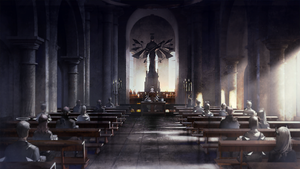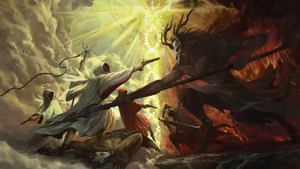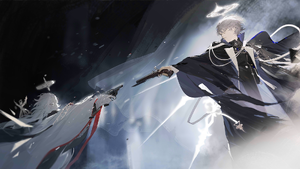Sankta
| Race | Trivia |
The Sankta (both singular and plural) are a race in the world of Arknights.
Overview
As the predominant race that has founded and resides in Laterano, Sankta are humanoids with halos above their heads and luminescent "wings" of varying shapes and sizes on their backs. These make them reminiscent of the angels in the Abrahamic religions of our world. The Sankta's halo is a physical object, preventing them from wearing any tall headwear that would cover it (e.g. conical party hats) although they can still wear most headwear as long as it is not too tall.[1] Their halos and wings will diminish upon death, and diseases or birth defects could affect them.
Sankta possesses several unique traits from other Terrans, such as their usage of firearms and their empathic trait. In fact, Sankta are famous for their strong faith in a religion established as the Lateran Church in which they follow the commandments provided by the Law. To a Sankta, they believe their unique traits are the blessings from the Law, and their halos and wings are honorary signs for these blessings.
Patron firearms
A patron firearm is, as its name suggests, a firearm (i.e., rifles, machine guns, submachine guns, shotguns) possessed by the Sankta which they keep for the rest of their lives owing to their culture. Historically, Sankta are the "discoverers" of firearms, a weapon that requires stable and precise channeling of Originium Arts upon Arts units etched on both the projectile and the bullets.[2] Sankta are born with well-attune Arts talent to harness its complexity. In fact, many Sankta have a religious view on their firearms in which they believe their weapons are granted by the Law as the symbol of their faith and that their talents are a blessing from the Law. As such, elements of guns can be seen in Lateran decorations and statues of saints.[3]
A Sankta receive their first patron firearm at the age of twelve as a coming-of-age gift. Although there are no clear rules stating that it is compulsory, it is a cultural norm for them to own one or even more than one firearm throughout their lifetime.[4] Even then, the usage of their firearm comes with strict regulations. Especially in Laterano, they have to undergo systematic firearm training for four years. After finishing their secondary education, it is compulsory to pass a firearm permit test to legally own one, and they are required to frequently go to the Notarial Hall for permit renewal and firearm maintenance. Those who break the rules too often will have their firearms confiscated and be blacklisted for ownership forever.[5] Upon death, the firearm will either be retrieved back by the Notarial Hall or will be handed to youngsters in the future.
Empathy
A Sankta's halo grants them a sixth sense called "empathy" which allows them to feel other Sankta's emotions when coming close to each other. This allows them to quickly understand the feelings of others and make responses in an intensive or sorrowful situation by showing their sympathy and understanding. Many presumptuously believe that their empathy is just merely "reading the room," but their empathy is more than that; it enables a Sankta to quickly respond to the emotion without wasting time in struggle with their inner self and accurately pinpoint the problem. In a descriptive way, their empathy is like a surgical loupe or a hearing aid that magnifies their physical capabilities.[6]
The Sankta empathy does receive criticism from others. Many non-Sankta races could not comprehend a Sankta's emotion which results in a psychological barrier between the two even though this is usually unintentional; hence, making friends with Sankta can be very tough.[7] In the past, the establishment of the belief in the Law was seen as a deprive of personal freedom by many non-Sankta, but through their empathy that could enable nearly-perfect social stability, the Sankta could establish Laterano as a utopianistic paradise upon Terra which persist in the present days.[6]
Errari
Errari[note 1] or "Exile," medically called Non-Pathological Empathic Impairment, is a condition which could strongly affect their emotions and communication skills. It is predominantly found among Sankta who have left their community for a long period of time, causing them to be unable to withstand the sudden flow of emotion when learning the Sankta culture once again. Although this does not bring harm to the bodies, it makes the patients confused when trying to use their empathy sense, such as not being able to understand one's inner feelings.[8]
The Law
- Main article: The Law
Sankta-Sarkaz origin
Being forgotten in history, Sankta actually shares a common ancestry with the Sarkaz as one of the three different races of Teekaz along with the Oni and Anasa. On the other hand, their shared origin results in their eternal conflicts against the Sarkaz. To a Sarkaz who could learn their history through their collective racial memory, the Sankta are viewed as "traitors" who choose to both ignore the eternal suffering of their sibling race and shed the blood of their brethren, and they continue to curse their betrayal to this day. On the other hand, the Sankta falsely presume the Sarkaz has ill intentions to destroy their holy city, and they are in fact accomplices in the worsening discrimination against the Sarkaz by non-Teekaz Terrans as they used their religious influence to portray them as irredeemable evil-doers.[9]
The origin of Sankta began from the first Saints of Laterano who were actually Sarkaz and their first contact with the Law in a suicidal mission. Millennia ago as the Teekaz civilizations collapsed by the invading alien Ancients and Elders, the Sarkaz desperately dug beneath the ground to search for relics that could turn the tide against the invaders. Like their ancestors facing the threats of the Silver Mountains, the excavation team met lethal threats from the defensive relics of the "First Civilization," which resulted in countless casualties in the process. The remaining survivors eventually reached the catacomb where the Law resides, but the moment of their first contact, these Sarkaz immediately received their Sankta traits that completely altered their biological traits as if their memories as Sarkaz were forever erased. These first Sankta later titled themselves as the first Saints of Laterano who founded the holy city, but the Sarkaz furiously condemned them for running away from their burdens which later resulted in the never-ending feud against the Sankta.[9]
To further worsen their relationship with the Sarkaz, the Sankta community and the Lateran regime as a whole have been intentionally rewriting their history and erasing any relics that could hint their Sarkaz origin. In some perspectives, such action is meant to protect themselves from the threats of the Ancients and Elders in the prehistoric past so that Laterano could be spared from bloodsheds and remain its neutrality, but on the other hand, it means they have to violently silencing dissidents which could often lead to potential diplomatic crisis. One such incident was the Kylian Excavation Scandal in 1042 when the Victorian archeologist Kylian Dougal excavated ancient santos of the First Saints that bore the faces of a Sarkaz and cubic faces resembling the Law which almost shook the very foundation of the Lateran faith, prompting Laterano to deploy violent means to silence his excavation team and destroy the santos.[10]
Because of their shared origin, a Sankta could also breed with a Sarkaz, and their child would still be accepted by the Law. Any Sankta who has a child with a member of another race will be guaranteed to have a non-Sankta offspring (e.g. the child of a Sankta-Forte couple will always be a Forte). But the child of a Sankta-Sarkaz couple can become a Sankta despite having a weaker halo as in Cecelia's case.[11]
Fallen
A fallen Sankta (often nicknamed "fallen angel") is someone who has broken the Law. There are many ways to fall, but the most well-known is by using their patron firearm against another Sankta (i.e. harming or killing). Any fallen Sankta will no longer be treated as a true Sankta. The punishments of a fallen Sankta can include but are not limited to:
- Having a dimmer or shattered halo and wings.
- Regrowing their dormant Sarkaz traits (i.e., tail and horns).
- Losing their ability to use their patron firearms, or being "rejected" by them in their words.
- Losing their racial empathy capability.
Fallen Sankta are still subjected to their national laws as well. They could be banished from their homeland or be placed under constant surveillance by an overseer. They must not reveal their status publicly within their homeland. At one point in the past, fallen Sankta were even persecuted as part of Laterano's intention to cover up such a secret.[12] Thankfully, the current Pope Yvangelista XI is quite lenient with the fallen Sankta and even allows them to serve the government as long as their "crime" is not severe.
What causes a Sankta to fall is determined by the Law without clear definitions.[13] While the Popes make Commandments that are interpretations of the demands of the Law, the ultimate interpretation of whether or not a Sankta falls rests with the Law itself. One example of a difference between Commandment and Law is the Commandment that Sankta cannot shoot each other with their patron firearms. At one point, Andoain and Yvangelista XI actually shot each other with their guns, but they did not fall.[12] It is implied that this is because the Law needs both of them to continue the existence of the Sankta.
Notable
| Addendum | ||
|---|---|---|
|
- Luciana Giallo
- Marcello Giallo
- Delfina (Hortus de Escapismo)
Etymology
Their name derives from the Esperanto word for "holy"/"sacred,"[14] with its root word originating from the synonymous Latin word, sanctus.[15] Alternatively, the name could also mean "saintess" in Swedish.[16]
See also
Notes
- ↑ Present passive infinitive of errō, "to go astray" in Latin
References
|




